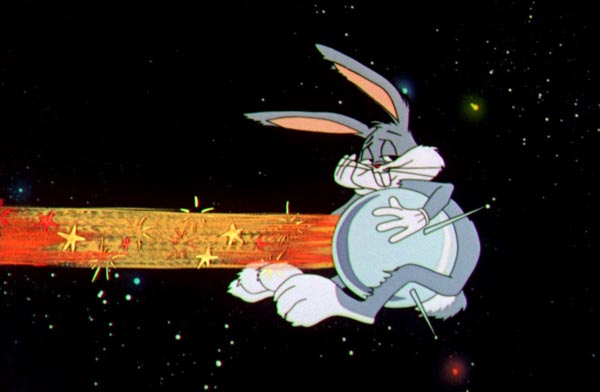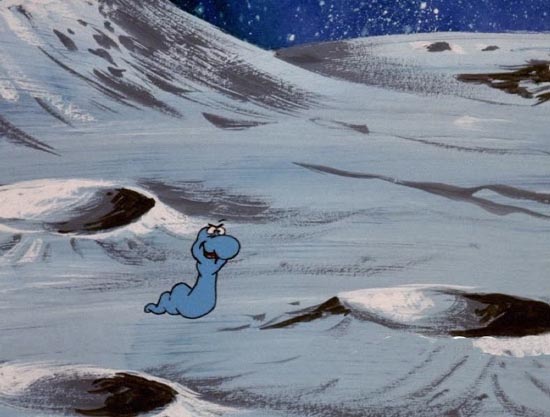
Every July various tributes to the first Moon landing and its astronauts appear in media. To contribute to that, my posting for this month is about theatrical cartoons that refer to the race between the United States and the Soviet Union to land on the Moon first. These cartoons contain illustrations of NASA astronauts, cosmonauts, Cape Canaveral, and Moon landings by representatives of nations. As such they differ from the cartoons that merely show individual characters exploring the galaxy and meeting creatures from outer space.
Early references to the space race consist of references to the Soviet satellite Sputnik, because the Soviet Union had just sparked the space race with its successful launch of the satellite in 1957. Warner Bros. Hare-Way to the Stars (1958) shows Sputnik striking Bugs Bunny during his rocket’s launch. Walter Lantz’s Woodpecker in the Moon caricatured the satellite even more severely in 1959. Woody flies in a rocket and encounters Sputnik, depicted with clothes hanging on a line tied between two antennae. As the United States entered the space race, animators moved on from poking fun at the satellite.
Instead, NASA’s facilities at Cape Canaveral, Florida became a target for light-hearted derision. In Paramount Cartoon Studio’s Cape Kidnaveral children build rocket ships. Woody Woodpecker goes to “Cape Carnival” in Lantz’s Rocket Racket.
These jokes disappeared in the aftermath of President John F. Kennedy’s assassination in 1963, when the federal government renamed the location Cape Kennedy for the first decade after his death.
Other cartoons of the early space race show the competitiveness between the two countries. Lantz’s Romp in a Swamp (1959) ends with an alligator flying through space. A Russian dog in a spacecraft eyes him and scowls, yelling in an accent, “Alligator, go home!” While trying to catch astronaut Jerry Mouse in space, Tom Cat accidentally opens the wrong space capsule and finds a Russian dog in the Metro-Goldwyn-Mayer cartoon Mouse Into Space (1962). Similarly, in the 1965 Warner Brothers cartoon Tease for Two, an explosion sends Daffy Duck so far into space that he encounters a cosmonaut who curses at him from a Russian vessel. The duck, channeling comedian Bob Newhart, responds, “Same to you, fella!”
With successful launches of Gemini and Apollo vessels in the early and middle 1960s, space-race cartoons of the late 60s focus less on the Soviet Union and concentrate on US space efforts. MGM’s Puss In Boats (1966) opts for patriotism, in which Tom blasts into space via a fire hose and greets an American astronaut on a spacewalk. Two years later the Warner Brothers-Seven Arts cartoon Feud with a Dude shows Merlin the Magic Mouse and his assistant Second Banana boarding a rocket to escape two rural predators. Then the film cuts to live-action footage of an actual NASA rocket launch.
As the 60s closed, studios began to visualize how actual Moon landings would look. Paramount’s My Daddy the Astronaut (1967) accurately predicted not only the United States reaching the Moon first but also planting a flag on lunar soil. When the astronaut puts the Stars and Stripes into the ground, the narrator says, “This shows that we own the Moon!”
DePatie-Freleng’s Transylvania Mania (1968), on the other hand, provides a direct reference to the race itself but without mentioning either Americans or the Soviets. The Inspector sends a vampire and his Frankenstein monster to the Moon with a rocket. As the rocket lands the Inspector remarks, “Who would’ve thought Transylvania would be the first country to get to the Moon?”
Animated references to the space race petered out after July 1969, when the first lunar landing took place, and NASA completed its manned lunar missions in December 1972. By then the United States had planted several flags on the Moon, and people saw the Moon for what it actually was–an orbiting, gray form made of rock and craters. Thus, the last short of the space race–DePatie-Freleng’s Fowl Play (1973)–more realistically depicts the Moon and astronauts’ exploration of it than previous cartoons. In the film the snake Blue Racer lands on the Moon, and American astronauts pass by him in a lunar rover, driving on gray, craggy and holey soil. Of course, animation studios continued to set cartoons in space, but the lunar rocks and the confirmed absence of lunar beings made any post-exploration cartoons about Moon creatures the objects of sheer and counter-factual fantasy.



 Christopher P. Lehman is a professor of ethnic studies at St. Cloud State University in St. Cloud, Minnesota. His books include American Animated Cartoons of the Vietnam Era and The Colored Cartoon, and he has been a visiting fellow at Harvard University.
Christopher P. Lehman is a professor of ethnic studies at St. Cloud State University in St. Cloud, Minnesota. His books include American Animated Cartoons of the Vietnam Era and The Colored Cartoon, and he has been a visiting fellow at Harvard University.



























Isn’t the “Rocky and Bullwinkle” serial where Boris and Bullwinkle vying to sing to the Mechanical Moon Mice an allusion to the space race?
It very well could be, but that’s a cartoon made for television.
There are two recent cartoons that also mention about the Space Race such as Toy Story 2 where Stinky Pete the Prospector was explaining to Woody why Woody’s Roundup (a Popular 1950’s tv show like Howdy Doody) was cancelled,… “Two Words, “Spud-Nik” Once the astronauts went up, children wanted to play with space toys.”
And a recent animated episode of The Sunny Bunnies aka Sunny & Funny a Russian CGI animated series entitled Bunnies on the Moon made reference about the old USSR/CCCP Satellite Sputnik that started the Space Race.
“Similarly, in the 1965 Warner Brothers cartoon Tease for Two, an explosion sends Daffy Duck so far into space that he encounters a cosmonaut who curses at him from a Russian vessel.”
Doesn’t he say “Dasvidanya, Americanski”? That would translate to “Goodbye, American.”
You’re probably right, could be more of a taunting than a cursing.
Goodbye American in Russian is actually pronounced as “Prostchay Amerikanets”.
You could also add to the discussion all of the Flying Saucer craze in the decade leading up to Sputnik: 1947-1957. One reason the U.S. government got involved in UFOs was due to their need to know everything the Soviets were up to. Of course, Sputnik looked nothing like a flying saucer.
I always considered JUMPIN’ JUPITER both funny (especially with its desert setting fitting well with Area 51), yet slightly disturbing in a race relations kind of way. Then again, maybe that was the point? I mean… how could Porky confuse a martian from outer space with a “friendly Nava-Joe” out to sell rugs and trinkets, unless this humanized pig thinks Nava-Joes are already alien to begin with? Even the martian himself is confused and must read up on DENIZENS OF THE PLANET EARTH AND THEIR BEHAVIOR. This joke eases whatever tension most of us feel with the earlier joke, since now the joke is on Porky being so stubborn in his narrow-sighted-ness that he is worse than Mister Magoo.
It has often been stated that science fiction is a great outlet for dealing with issues not easily covered in other, more straight-forward, artistic works. Mind you, I don’t think the Chuck Jones unit at Warner Brothers were necessarily consciously making a statement in their cartoons and probably were not as concerned about civil rights issues as others in their day, due to being mostly Caucasian and heterosexual and, thus, not suffering as much prejudice or inhibitions. Yet I consider ROCKET-BYE BABY interesting in how the parents are trying to view their baby as just as normal as any other, but even Daddy is gets overly worried when a lady comments on the tot’s “green” skin tone. The creators may have seen themselves in that cartoon daddy, accepting of others as live-and-let-live but not comfortable if a family member doesn’t fit in well enough with the neighbors. Backtracking a few years earlier, the Bugs Bunny cartoons were quite “gay-friendly” and having “a good Earth out tonight” allows plenty of wooing with K-9 in HAREDEVIL HARE.
It would be fun to somehow add in the delightful Pink Panther short TWINKLE TWINKLE LITTLE PINK into the discussion, since it was released in the summer of 1968 pre-Apollo 8 & 11,but… obviously… it does not belong to this discussion. Also astronomer-with-big-telescope gag-fests stretch pretty far back through the decades.
I’ve read scholarship about films involving space alien invasions and how they could be metaphors for fears about desegregation. Those two cartoons from Jones could certainly qualify, especially “Rocket-Bye Baby.” As for “Twinkle Twinkle Little Pink,” it could fit in today’s discussion as a late-’60s blending of reality and fantasy. By 1968 we knew the Moon was rocky and cratered, but we had not yet landed there. Thus, the tap-dancing aliens provide a last-minute “what if men were on the Moon” joke.
The Soviet cosmonaut doesn’t curse at Daffy- he says “Do Svidanya” which is a polite “goodbye” Daffy of course misinterprets this
As apparently have I. Thanks.
A 1961 interstitial segment for HUCKLEBERRY HOUND involves Huck and company doing a show on the Moon. Mr. Jinks tries to catch some “moon meeces”, while Hokey Wolf guides Huck on a rather short Moon Tour (“Well, you see one moon, you see them all!”).